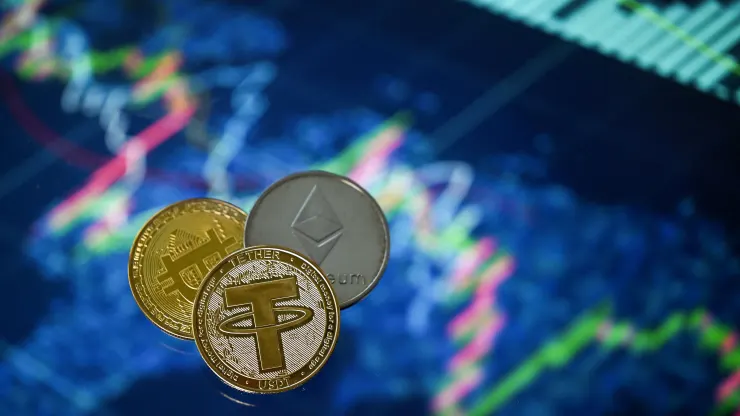Cryptocurrency giant Tether on Wednesday said that it’s going to purchase hundreds of millions of dollars’ worth of bitcoin to back the world’s largest stablecoin.
The company said it would invest 15% of its net profit into bitcoin to “diversify” the reserves that back its USDT token, which aims to stick to a 1-to-1 peg to the U.S. dollar.
That would amount to roughly $222 million, based on the company’s last attestation report, which provides a breakdown of the assets that make up its USDT reserves as well as excess reserves and profits.
A Tether spokesperson clarified the bitcoin it purchases would amount to only a small portion of its overall net profit, with the bulk of excess income being spent on running the business, including bank fees.
“The aim is to keep the Bitcoin portfolio value well below the size of our total excess reserves that accounted for 2.48B at the end of Q1/2023, while bitcoin holdings accounted for 1.5B,” the Tether spokesperson said.
USDT is the largest stablecoin in the market, with a circulating supply of more than $82.8 billion, according to CoinGecko data. It competes with Circle’s USD Coin and Binance’s BUSD.
Stablecoins are used by traders to move in and out of different cryptocurrencies without converting money back into fiat currencies.
“The decision to invest in Bitcoin, the world’s first and largest cryptocurrency, is underpinned by its strength and potential as an investment asset,” Tether CTO Paolo Ardoino said in a statement.
“Bitcoin has continually proven its resilience and has emerged as a long-term store of value with substantial growth potential. Its limited supply, decentralized nature, and widespread adoption have positioned Bitcoin as a favored choice among institutional and retail investors alike.”
The move would make Tether an even bigger holder of bitcoin — the firm already holds over $1.5 billion worth of bitcoin on its balance sheet — and follows moves from notable investors like Paul Tudor Jones and MicroStrategy boss Michael Saylor to accumulate huge stockpiles, in the belief that the token is immune to the effects of currency depreciation and inflation.
Analysts and investors have previously told CNBC that bitcoin could get a boost this year due to the influence of so-called “whales” — market players with significant financial firepower, which enables them to buy up huge sums of tokens.
Tether’s methods to maintain a $1 value for its token have drawn controversy in the past because of concerns over the quality of its reserve assets. Previously, the company held a great deal of its reserves in commercial paper — a form of short-term, unsecured debt issued by companies. This is seen as less safer than other forms of debt, such as U.S. Treasury bills.
Tether sought to allay investor fears by rotating out of commercial paper and replacing these fund holdings with only U.S. government debt securities.
In February, the company said it had whittled down its commercial paper holdings to zero.
USDT and its issuer remain a source of contention in the crypto market. The U.S. Department of Justice is reportedly investigating executives at Tether over possible bank fraud.
Stablecoins were already a hot-button issue for regulators, who have been scrambling to figure out how to keep the industry in check after the demise of several notable firms in the space.

